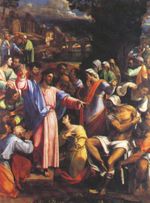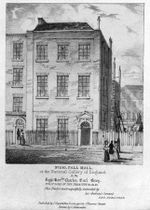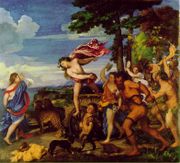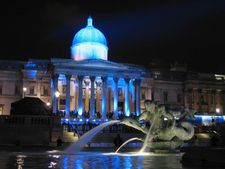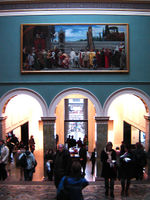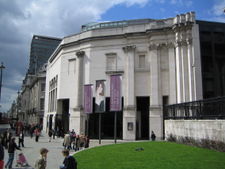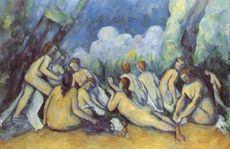National Gallery, London
2007 Schools Wikipedia Selection. Related subjects: Architecture; Art
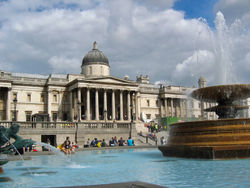 |
|
| Established | 1824 |
|---|---|
| Location | Trafalgar Square, London WC2, England, United Kingdom |
| Visitor figures | 4,200,000 (2005) |
| Director | Charles Saumarez Smith |
| Nearest tube station(s) | Charing Cross, Embankment, Leicester Square |
| Website | www.nationalgallery.org.uk |
The National Gallery is an art gallery in London, located on the north side of Trafalgar Square. It houses Western European paintings from 1250 to 1900 from the national art collection of Great Britain. The collection of 2,300 paintings belongs to the British public, and entry to the main collection is free, although there are charges for entry to special exhibitions.
Despite having been founded without an existing royal collection on which to build, the National Gallery has grown to be a collection of international renown since its foundation in 1824. It was shaped mainly by its early directors, including Sir Charles Lock Eastlake, and by private donations, which comprise two thirds of the collection. Although small in comparison with other national art collections such as the Louvre, the National Gallery is notable for covering a broad art-historical scope with paintings of consistently high quality, making it possible to trace every major development in Western painting from the Early Renaissance to the Post-impressionists through its collection. The Gallery's 19th-century origins have, however, resulted in particularly strong holdings of the Italian and Dutch schools, while historically it was slow on the uptake of modern art.
The National Gallery has been housed in three buildings, all of which have been deemed inadequate for their purpose at one point or another. The present building, begun by William Wilkins, has undergone several extensions, most notably by E. M. Barry and Robert Venturi. The current director is Charles Saumarez Smith.
History
Founding bequests and early history
Compared with the majority of European nation states, Great Britain was a late starter in establishing a national art collection open to the public. Whereas the great galleries of continental Europe, such as the Uffizi in Florence or the Prado in Madrid, were built on royal or princely art collections that had been nationalised, the British Royal Collection remained in the possession of the sovereign, dispersed across various royal palaces. The private collection assembled by Sir Robert Walpole at Houghton Hall in Norfolk was of comparable quality to the monarch's, and when his descendants threatened to put it up for sale in 1777 there were calls for it to be bought by the government. John Wilkes, speaking to the House of Commons, suggested that a national gallery be established as an adjunct to the British Museum. The government paid no heed to Wilkes's appeal and 20 years later the collection was bought in its entirety by Catherine the Great; it is now to be found in the State Hermitage Museum in St Petersburg. Later, in 1811, London became home to a collection intended for a never-realised national gallery of Poland when it was bequeathed in the will of one of one of the men who had assembled it, Sir Francis Bourgeois, to Dulwich College (it now resides in the Dulwich Picture Gallery). But with the college being a private institution in a South London suburb, the British capital remained without a state-owned national gallery in a central location until after the Napoleonic Wars.
The unexpected repayment of a war debt by Austria finally moved the hitherto reluctant British government to establish a National Gallery, just as the art collection of John Julius Angerstein, a Russian émigré banker who had died the previous year, appeared on the market. On April 2, 1824, the House of Commons voted to purchase 38 of Angerstein's paintings, including works by Raphael and Hogarth's Marriage à-la-Mode series, for £60,000. The National Gallery opened to the public on May 10, 1824, housed in Angerstein's former townhouse on No. 100 Pall Mall. Angerstein's paintings were joined in 1826 by those from the collection of Sir George Beaumont, which he had offered to give to the nation three years previously on the condition that a suitable building would be found to house them, and in 1828 by the Reverend William Holwell Carr's bequest of 34 paintings. Initially the Keeper of Paintings, William Seguier, bore the burden of managing the Gallery, but in July 1824 some of this responsibility fell to the newly-formed board of trustees.
The National Gallery at Pall Mall was frequently overcrowded and hot and its diminutive size in comparison with the Louvre in Paris was the cause of national embarrassment. Subsidence in No. 100 caused the Gallery to move briefly to No. 105 Pall Mall, which the novelist Anthony Trollope called a "dingy, dull, narrow house, ill-adapted for the exhibition of the treasures it held". In 1832 construction began on a new building by William Wilkins on the site of the King's Mews in Charing Cross, in an area that had been transformed over the 1820s into Trafalgar Square. The location was a significant one, described by the trustee Sir Robert Peel as being "in the very gangway of London" and thus equally accessible by people of all social classes. Later, in the 1850s, there were calls for a change of location, due in part to the pollution of central London and partly because of the failings of Wilkins's building, but it was felt that moving the National Gallery from Trafalgar Square would undermine public access.
Growth under Eastlake and his successors
15th- and 16th-century Italian paintings were at the core of the National Gallery and for the first 30 years of its existence the Trustees' independent acquisitions were mainly limited to works by High Renaissance masters. Their conservative tastes resulted in several missed opportunities and the management of the Gallery later fell into complete disarray, with no acquisitions being made between 1847 and 1850. A critical House of Commons Report in 1851 called for the appointment of a director, whose authority would surpass that of the trustees. Many thought the position would go to the German art historian Gustav Friedrich Waagen, whom the Gallery had consulted on previous occasions about the lighting and display of the collections. However, the man preferred for the job by Queen Victoria, Prince Albert and the Prime Minister, Lord Russell, was the Keeper of Paintings at the Gallery, Sir Charles Lock Eastlake.
The new director's taste was for the Northern and Early Italian Renaissance masters or "primitives", who had been neglected by the Gallery's acquisitions policy but were slowly gaining recognition from connoisseurs. Eastlake made annual tours to the continent and to Italy in particular, seeking out appropriate paintings to buy for the Gallery. In all, he bought 148 pictures abroad and 46 in Britain, among the former such seminal works as Paolo Uccello's Battle of San Romano. Eastlake also amassed a private art collection during this period, consisting of paintings that he knew did not interest the trustees. His ultimate aim, however, was for them to enter the National Gallery; this was duly arranged upon his death by his friend and successor as director, William Boxall, and his widow Lady Eastlake.
The third director, Sir Frederick William Burton, laid the foundations of the collection of 18th-century art and made several outstanding purchases from English private collections, including The Ambassadors by Hans Holbein the Younger. The last decisive influence in the shaping of the Gallery was the founding of the National Gallery of British Art, or the Tate Gallery as it was already being called, in 1897. The stipulation that paintings by British artists born after 1790 should be given to the Tate allowed the National Gallery to shed many of the superfluous works in its collection, while keeping those by Hogarth, Turner and Constable. As the building at the time was still comprised of only 15 rooms, this de-cluttering exercise proved to be a boon to the Gallery, allowing it to display its paintings by the British School with better focus than was previously possible.
The early twentieth century
In 1906 Velázquez's Rokeby Venus, the first high-profile acquisition by the National Art Collections Fund, was the first of many artworks bought by the Fund for the National Gallery. In a rare example of the political protest for which Trafalgar Square is famous occurring in the National Gallery, the canvas was slashed on May 10, 1914 by Mary Richardson, a campaigner for women's suffrage, in protest against the arrest of Emmeline Pankhurst the previous day. Later that month another suffragette attacked five Bellinis, causing the Gallery to close until the start of the First World War, when the Women's Social and Political Union called for an end to violent acts drawing attention to their plight.
The bequest of 42 paintings given by the chemist Dr Ludwig Mond in 1909 was one of the largest ever received by the gallery and strengthened its holdings in the Italian old masters. During the 19th century the National Gallery contained no works by a contemporary artist, but this situation was belatedly amended by Sir Hugh Lane's bequest of Impressionist paintings in 1917. A fund for the purchase of modern paintings established by Samuel Courtauld in 1924 bought Seurat's Bathers at Asnières and other notable modern works for the nation; in 1934 these transferred to the National Gallery from the Tate.
The Gallery in World War II
At the outbreak of World War II the paintings were exiled to safety in Manod Quarry, near the town of Ffestiniog in North Wales. Originally the director Kenneth Clark hoped to ship the paintings from Wales to Canada, but he received a telegram from Winston Churchill exhorting him to “bury them in caves or in cellars, but not a picture shall leave these islands”. In the meantime the pianist Myra Hess gave daily recitals in the empty building to raise public morale at a time when every concert hall in London was closed. In 1941 a request from an artist to see Rembrandt's Portrait of Margaretha de Geer resulted in the "Picture of the Month" scheme, in which a single painting was removed from Manod and exhibited to the general public in the National Gallery each month.
Post-war developments
In the post-war years acquisitions have become increasingly difficult for the National Gallery as the prices for Old Masters – and even more so for the Impressionists and Post-impressionists – have risen beyond its means. Some of the Gallery's most remarkable purchases in this period would have been impossible without the major public appeals backing them, including The Virgin and Child with St. Anne and St. John the Baptist by Leonardo da Vinci (bought in 1962), Titian’s Death of Actaeon (1972) and Raphael’s Madonna of the Pinks (2004). Other campaigns, such as that to acquire Titian's Portrait of a Young Man for the nation in 2005, have been unsuccessful. Private individuals have continued to give their support, the most generous of whom was the late Sir Paul Getty, who in 1985 gave the Gallery £50 million towards acquisitions. Ironically, the institution that posed the biggest threat to the Gallery's acquisitions policy was (and remains) the extremely well-endowed J. Paul Getty Museum in California, established by Getty's estranged father. Also in 1985 Lord Sainsbury of Preston Candover and his brothers, the Hon. Simon Sainsbury and Sir Timothy Sainsbury, made a donation that enabled the construction of the Sainsbury Wing.
In 1996 it was decided that 1900 would be the 'cut-off date' for paintings in the National Gallery and the following year more than 60 post-1900 paintings from the National Gallery collection were given to the Tate on a long-term loan, in return for works by Gauguin and others. The agreement was remarkable for marking an end to a century of cool relations between the two galleries. Future expansion of the National Gallery may see the return of twentieth-century paintings to its walls. Another gap in the collection was addressed by a bequest from Sir Denis Mahon in 1999, an art historian and collector of Italian Baroque paintings at a time when they were considered beyond the pale by most in the profession. This prejudice extended to the National Gallery trustees, who declined the offer to buy a Guercino from his collection for £200 in 1945 (in 2003 it was evaluated at £4m). Mahon left the National Gallery 26 of his paintings, including works by Guido Reni and Correggio, on the condition that it never charge for admission.
Controversies
One of the most persistent criticisms of the National Gallery, alongside the perceived inadequacies of the building, has been of its policy regarding the conservation of paintings. The Gallery's detractors accuse it of having an over-zealous approach to restoration and of turning a deaf ear to criticism. The first cleaning operation at the National Gallery began in 1844 after Eastlake's appointment as Keeper, and was the subject of attacks in the press after the first three paintings to receive the treatment – a Rubens, a Cuyp and a Velázquez – were unveiled to the public in 1846. The Gallery's most virulent critic was J. Morris Moore, who wrote a series of letters to The Times under the pseudonym "Verax" savaging the institution's recent cleanings. While an 1853 Parliamentary Select Committee set up to investigate the matter cleared the Gallery of any wrongdoing, criticism of its methods has been erupting sporadically ever since from some in the art establishment.
The last major outcry against the use of radical conservation techniques at the National Gallery was in the immediate post-war years, following a restoration campaign by Chief Restorer Helmut Ruhemann while the paintings were in Manod Quarry. When the cleaned pictures were exhibited to the public in 1946 there followed a furore with parallels to that of a century earlier. The principal criticism was that the extensive removal of varnish, which was used in the 19th century to protect the surface of paintings but which darkened and discoloured them with time, may have resulted in the loss of "harmonising" glazes added to the paintings by the artists themselves. The opposition to Ruhemann's techniques was led by Ernst Gombrich, a professor at the Warburg Institute who in later correspondence with a restorer described being treated with "offensive superciliousness" by the National Gallery. A 1947 commission concluded that no damage had been done in the recent cleanings, but some in conservation circles remain unhappy that the Gallery's attitude towards restoration has changed little since Ruhemann's time.
The National Gallery has also come under fire for misattributing paintings for various reasons. Kenneth Clark's decision in 1939 to relabel a group of paintings by anonymous artists in the Venetian school as works by Giorgione (a crowd-pulling artist due to the rarity of his paintings) caused an outrage and made him deeply unpopular with his own staff, who locked him out of the library. More recently, the attribution of a 17th-century painting of Samson and Delilah (bought in 1980) to Rubens has been contested by a group of art historians, who believe that the National Gallery has not admitted to the mistake to avoid the embarrassment of those who were involved in the purchase, many of whom still work for the Gallery.
The building
The first suggestion for a National Gallery on Trafalgar Square came from John Nash, the architect of the Square. A competition for the site was eventually held in 1832, for which Nash submitted a design with C. R. Cockerell as his co-architect. Nash's popularity was waning by this time, however, and the commission was awarded to William Wilkins, who was involved in the selection of the site and submitted some drawings at the last moment. Wilkins described in a letter to the Viscount Goderich his desire to build a "Temple of the Arts, nurturing contemporary art through historical example", but his plans were hampered by parsimony and compromise. From its completion the building was generally regarded as an unsatisfying focal point for the northern end of Trafalgar Square. The main criticisms of the façade were that it was excessively long, without sufficient bulk, and fussy in its ornamentation. (The arrangement of turrets and a dome on the roofline has been described by the architectural historian Sir John Summerson as being "like the clock and vases on a mantelpiece, only less useful".) The building's failings are best understood by examining the constraints imposed on Wilkins's creativity by the site and other demands of the commission.
Wilkins would have preferred to build the Gallery farther to the south than the current building, but this would have eliminated the protected vista of the church of St Martin-in-the-Fields. A further problem was that a workhouse and a barracks stood immediately behind Wilkin's building. Not only did this confine it to being one room deep, but there was also a public right of way through the site of the National Gallery to these buildings, which Wilkins was forced to incorporate into his design. Hence the western and eastern porticoes of the building, with columns recovered from the demolished Carlton House – their reuse was yet another stipulation of the commission. Also recycled are the relief sculptures on the façade, originally intended for Nash's Marble Arch but abandoned due to his financial problems.
Even the space given to the National Gallery inside the building was ungenerous as the eastern half of the building was occupied by the Royal Academy until 1868, when it moved to its present home in Burlington House. The building was the undoing of Wilkins's reputation and two years before its completion it was mocked by A. W. N. Pugin in his influential tract against classical architecture, Contrasts. The first significant alteration made to the building was Sir James Pennethorne’s central vestibule, built in 1860-1, but exhibition space remained at a premium as the collections continued to grow.
Unsurprisingly, several attempts were made either to completely remodel the National Gallery (as suggested by Sir Charles Barry in 1853), or to move it to more capacious premises in Kensington, where the air was also cleaner. In 1867 Barry’s son Edward Middleton Barry proposed to replace the Wilkins building with a massive classical building with four domes. The scheme was a failure and contemporary critics denounced the exterior as "a strong plagiarism upon St Paul's Cathedral". With the demolition of the workhouse, however, Barry was able to build a suitably grand eastern extension from 1872 to 1876. Barry’s East Wing, with the huge octagonal tribune at its centre, compensated for the underwhelming architecture of the Wilkins building and remains the most monumental part of the building. Its strong axial plan was followed by all subsequent additions to the Gallery for a century, resulting in a building of clear symmetry.
Pennethorne’s alterations were all but demolished for the next phase of building, a scheme by Sir John Taylor extending northwards of the main entrance. Taylor’s glass-domed entrance vestibule had an opulent decorative scheme by the Crace firm, hidden under austere white paint and marble cladding in the Second World War, and recreated during restoration in 2005. On the south wall hangs Frederic, Lord Leighton’s painting of Cimabue's Celebrated Madonna carried in Procession through the Streets of Florence, illustrating a scene from Vasari’s Lives of the Artists. The quirky floor mosaics were designed by Boris Anrep from 1928 to 1952 and include, at the centre of the room, a depiction of luminaries of the era in classical guises (The Awakening of the Muses), while the outlying mosaics illustrate Modern Virtues, The Labours of Life and The Pleasures of Life (including Christmas pudding).
Later additions to the west came more steadily but maintained the coherence of the building by mirroring Barry’s cross-axis plan to the east. The use of dark marble for doorcases and skirting-boards was also continued, giving the extensions a degree of internal consistency with the older rooms. The classical style was still in use at the Gallery as late as 1929, when the Duveen gallery with its coffered, barrel-vaulted ceiling was built. The symmetry of the building was broken by the North Galleries, an unloved modernist extension which opened in 1975. The 1980s and '90s saw a progamme of refurbishing the entire principal floor, beginning in 1985-6 with the Barry rooms. This was also an attempt to reconcile the disparate post-war buildings with the main building by decorating them in a 19th-century style.
The Sainsbury Wing and later additions
The most important addition to the building in recent years has been the Sainsbury Wing, designed by the leading postmodernist architect Robert Venturi to house the collection of Renaissance paintings and built in 1991. Building on the site had been delayed after Prince Charles infamously denounced a still evolving design for a modernist extension to the gallery by the architects Ahrends, Burton and Koralek as "a monstrous carbuncle on the face of a much-loved and elegant friend". The proposed extension then under consideration would have included a block of offices under the galleries. This proposal went as far as the display of a scale model at the Royal Academy in 1983. Only after the Sainsbury family's 1985 donation did a building exclusively for use by the National Gallery become financially feasible. Given the sensitivity of the site it is unsurprising that the Sainsbury Wing is subdued by Venturi's standards, superficially blending in with the Wilkins façade whilst offering a quirky comment on classical architectural idiom.
In contrast with the rich ornamentation of the rooms that either date from or emulate the 19th century, the galleries in the Sainsbury Wing are deliberately pared-down and intimate, to suit the smaller scale of many of the paintings. Sir John Soane's toplit galleries for the Dulwich Picture Gallery are the main inspiration for these rooms, and the white walls with grey pietra serena stone details (for door surrounds etc.) are a nod to the Florentine Renaissance architect Filippo Brunelleschi. The northernmost galleries align with Barry's central axis, so that there is a single continuous vista down the whole length of the Gallery. Looking towards the Sainsbury Wing from the main building, this prospect is given added drama by the use of false perspective as the paired columns flanking each opening gradually diminish in size until the visitor reaches the focal point of the vista (as of 2006), an altarpiece by Cima of The Incredulity of St Thomas. Venturi's postmodernist approach to architecture is in full evidence at the Sainsbury Wing, with its stylistic quotations from buildings as disparate as the clubhouses on Pall Mall, the Scala Regia in the Vatican, Victorian warehouses and Ancient Egyptian temples.
Following the pedestrianisation of Trafalgar Square, the Gallery is currently engaged in a 'master plan' to convert the vacated office space on the ground floor into public space. The plan will also fill in disused courtyards and make use of land acquired from the adjoining National Portrait Gallery in St Martin's Place, which it gave to the National Gallery in exchange for land for its 2000 extension. The first phase, the East Wing Project designed by Jeremy Dixon and Edward Jones, opened to the public in 2004. This provided a new ground level entrance from Trafalgar Square. The main entrance was also refurbished, and reopened in September 2005. Possible future projects include a "West Wing Project" roughly symmetrical with the East Wing Project, which would provide a future ground level entrance, and the public opening of some small rooms at the far eastern end of the building acquired as part of the swap with the National Portrait Gallery. This might include a new public staircase in the bow on the eastern façade. No timetable has been announced for these additional projects.
Collection highlights
Paintings in the National Gallery include:
|
|
Directors
| Director | Served |
|---|---|
| Sir Charles Lock Eastlake PRA | 2 July 1855 – 24 December 1865 |
| Sir William Boxall RA | 13 February 1866 – 1874 |
| Sir Frederick William Burton | 20 February 1874 – March 1894 |
| Sir Edward Poynter Bt PRA | April 1894 – 1904 |
| Sir Charles Holroyd | 11 June 1906 – June 1916 |
| Sir Charles Holmes | 4 August 1916 – December 1928 |
| Sir Augustus Daniel | January 1929 – December 1933 |
| Sir Kenneth Clark | January 1934 – December 1945 |
| Sir Philip Hendy | January 1946 – December 1967 |
| Sir Martin Davies CBE Dlitt FBA FSA | January 1968 – September 1973 |
| Sir Michael Levey MVO | October 1973 – December 1986 |
| Neil MacGregor | January 1987 – May 2002 |
| Dr Charles Saumarez Smith | July 2002 – present |
Associate artists
Since 1989, the gallery has run a scheme that gives a studio to contemporary artists to create work based on the permanent collection. They usually hold the position of associate artist for two years and are given an exhibition in the National Gallery at the end of their tenure. The list of associate artists so far is as follows:
- Paula Rego (1989–90)
- Ken Kiff (1991–93)
- Peter Blake (1994–96)
- Ana Maria Pacheco (1997–99)
- Ron Mueck (2000–02)
- John Virtue (2003–05)
- Alison Watt (2006–08)
